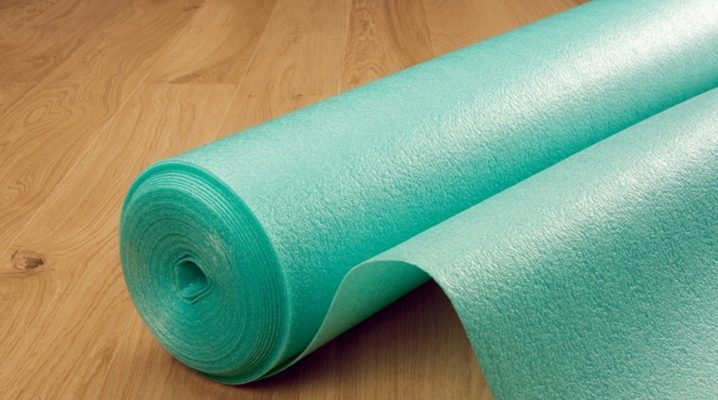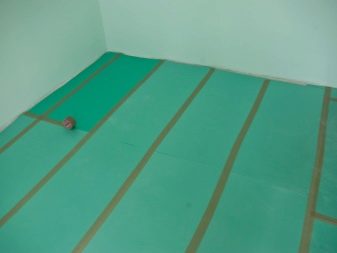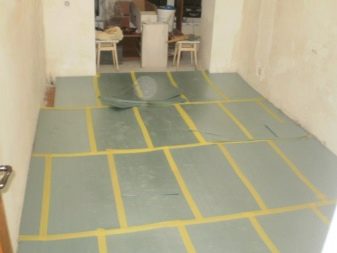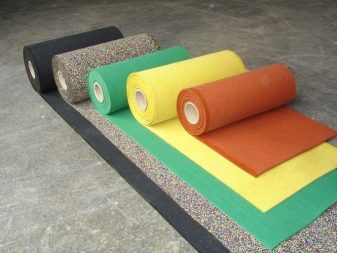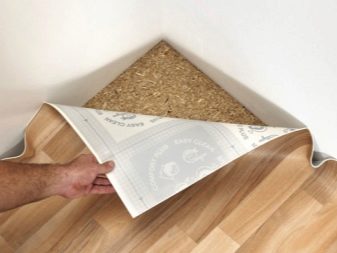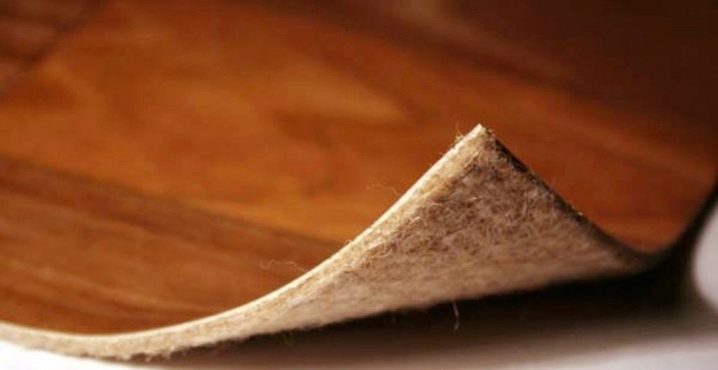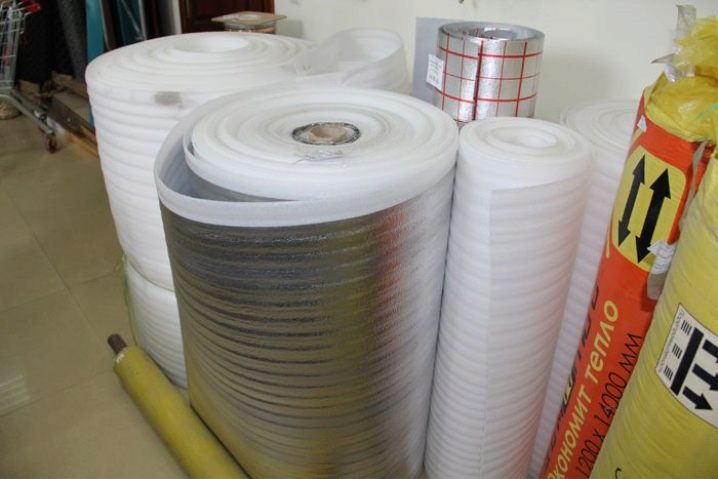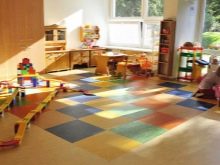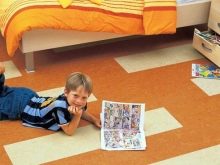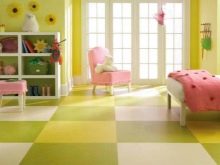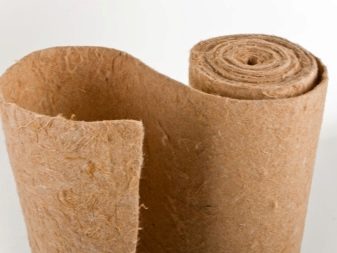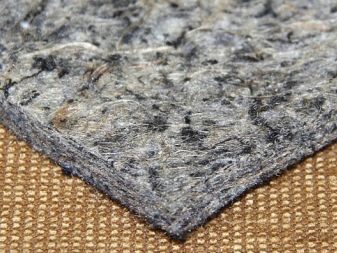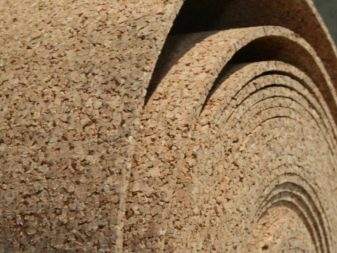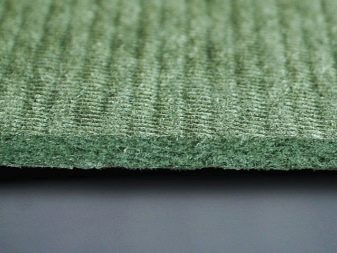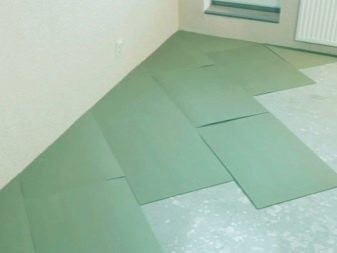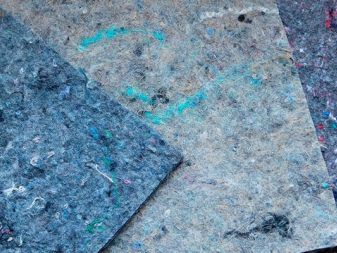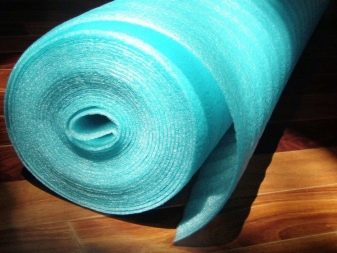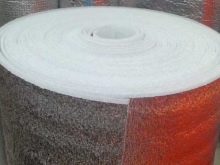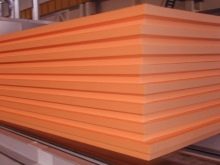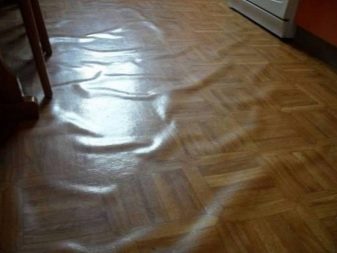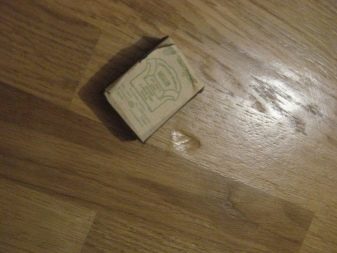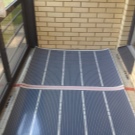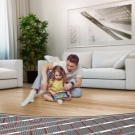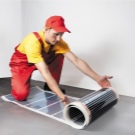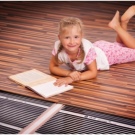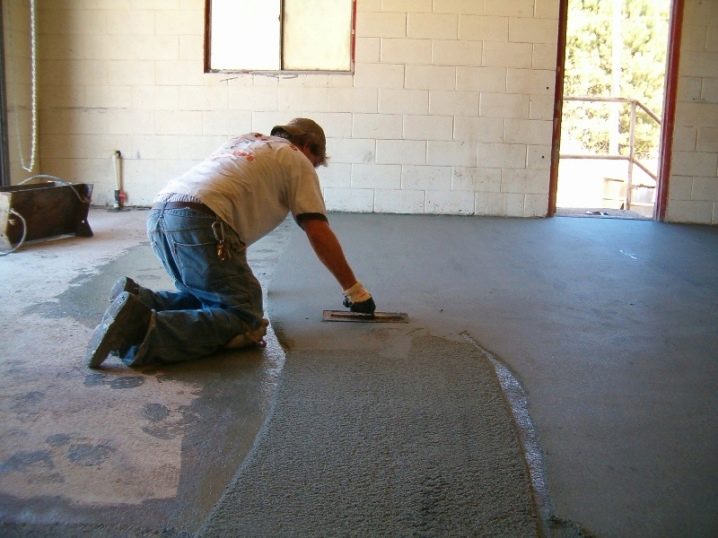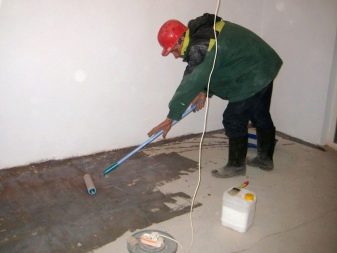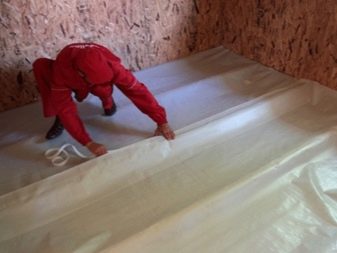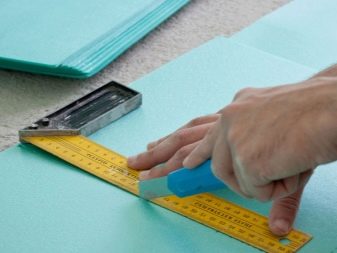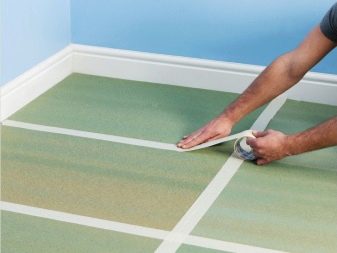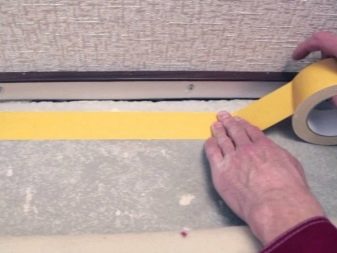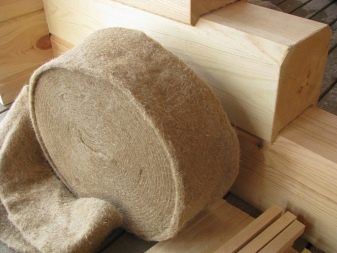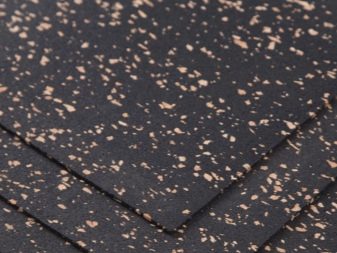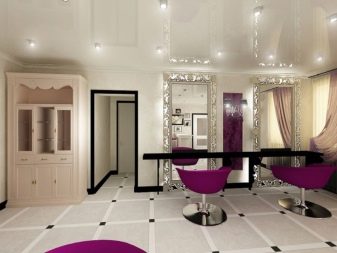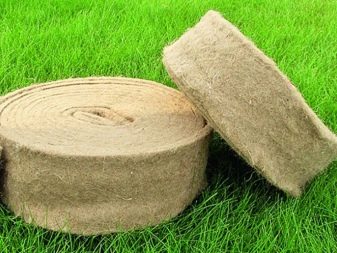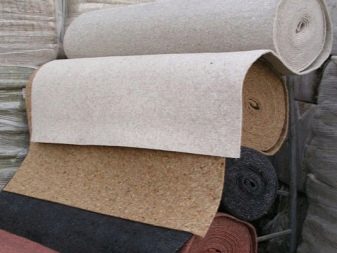Substrate under linoleum on concrete floor
Facing the floor has its own nuances. It is good if the flooring is laid on fiberboard or self-leveling floor. It is quite another thing if the floor surface is concrete, but it is necessary that the linoleum lay flawlessly.
Do not miss the important stages of preparation of the base, one of which is the mounting substrate.
The substrate under the linoleum on the concrete floor performs several functions, and the material has features that determine the degree of its relevance in each particular case.
Special features
The substrate is a special material of natural or synthetic origin of roll or sheet type, used when laying linoleum. More often it is sold in the form of rolls of meter width, making 10 m in length.This is an additional layer with a thickness of 2 to 10 mm, which is placed between the linoleum and the concrete base. It is mobile in transportation: after buying it, it is easy to bring it home, as it fits in the trunk of a car.
The material may differ in appearance, has a different color and texture, while regardless of the appearance and components, performs several functions:
- It is a noise insulating material, through which it is possible to reduce the level of annoying extraneous sounds coming from neighboring apartments;
- Reduces the amount of heat loss, being a floor heater (without it, the floor is much colder);
- In the case of minor defects, the surface of the concrete base is a floor rover;
- Increases the life of the flooring by getting rid of contact with the base of the floor (is a hydro-barrier).
It is worth making a reservation about the appropriateness of the use of the substrate under the linoleum. It is not suitable for every type of linoleum.
If the floor covering of the multilayer (heterogeneous) type has a jute or felt layer, the substrate is not needed. In this case, it is already there, so the second is not necessary.Linoleum with a substrate can be recognized by the thickness, which is about 5 mm, as well as the back side, which does not have a foam base.
The substrate under the linoleum can be used in different types of premises: industrial, warehouse, in an apartment and a private house. It differs in texture and can be soft, hard, loose, dense, as well as the load on the working surface. The application is based on the specific features of the room. Each type of insulation layer is designed for a different floor.
For example, humidity is important: some materials are completely unsuitable for use in such rooms, under these conditions they can rot, acquire mold or moth. Others are pressed, which is no good at all.
There are cases of facing the floor, when you can not do without a substrate.
It is necessary in the following situations:
- When installing a private house with an unheated basement or in an apartment on the first floor of the MKD;
- If the floor is incredibly cold, even with carpet;
- In old apartment buildings with poor noise insulation.
It can not be laid on the old coating or other material that was in use.This can lead to a rotting process on the old surface.
High-quality substrate will save heat. Being located tightly to the floor, it will give the linoleum an even look, relieve the floor of coolness, which is especially important if there are children or households with poor health in the house.
Species
The substrate under the linoleum is different. Each type has its own characteristics, has advantages and disadvantages, which are taken into account when laying linoleum.
The names of the varieties are required composition.
- Jute the layer is pressed from natural and artificial fibers, it perfectly absorbs and removes moisture, while not destroying the structure of linoleum, has a refractory and antibacterial impregnation, has a fire retardant, but is expensive;
- Flaxseed the variety is based on fiber flax, it is environmentally friendly, supports ventilation between the flooring and the surface of the subfloor, does not rot, eliminates the formation of microorganisms, is not susceptible to mold, is fire resistant and is excellent for rooms for allergies, sold in rolls, made by double penetration needle;
- Corkboard the layer is a product of processing of wood bark, it is natural, has high levels of noise and heat insulation, however it is completely unsuitable for installation in the room where heavy furniture will be located (this type is pressed through and has a soft structure);
- Conifer the variety is one of the best dampers under the floor covering, it is made from crushed coniferous tree species, it is found on sale in the form of sheets, tiles, rolls, is up to 7 mm thick, dampens sound vibrations, masks uneven floors, does not sag, does not shrink, does requires the use of glue during installation, although it is prone to the formation of mold and is not intended for rooms with high humidity;
- Combined material consists of a combination of flax, wool and jute fibers in equal shares, it is a universal solid substrate with high wear-resistant properties and maximum heat saving (due to the presence of wool fibers in the composition the floor will be as warm as possible, jute will give the interlayer stiffness and excellent wear-resistant performance);
- Foamed the layer is significantly inferior to the previous analogues in all respects: it practically does not warm the floor, bends under the weight of the furniture supplied, loses its shape,sagging and decreasing in thickness (its only advantage is the price, although the loss on quality is much greater).
The main varieties of the polymer substrate used on the concrete floor include the following:
- Styrofoam plates;
- Rolled penofol;
- Foil isolon.
Which is better?
In this case, the eloquent response is the price. Existing types of substrate have clear distinctions: budget materials include isolon, penofol and other synthetic analogues. They will last less than the others, they will instantly be compressed even during normal walking, making the thickness of the interlayer different as the pressure on the floor covering surface. Moreover, the collapse will be uneven, which will affect the appearance of the floor covering.
If the repair does not provide for ceased flooring after a couple of years, it is necessary to exclude polymer and foam layers from the priority list for insulation and leveling the floor.
If you do not want to engage in double work, it is better to opt for felt and linen materials. However, the best options are cork analogue of insulation and jute substrate.Such coatings are quite dense and able to retain their properties for 20-30 years, without needing to be replaced.
Unfortunately, not all stores have these materials: they are expensive, so sellers often put more acceptable options for substrates on the shop windows, focusing on the mass buyer. If suddenly there is a combined substrate on the counter, it is the best option for sound and heat insulation of the budget type.
Installing the flooring on a concrete floor does not allow hard sheets of plywood or fiberboard to be placed on it. In 100% of cases, this insulation absorbs moisture and swells.
Often, experts suggest that several materials be used as a heat insulation material, performing the preparation of a multilayer composite base for linoleum. For example, this method is used when facing a concrete floor on a balcony, using the “infrared floor” system, which does not react to the effects of moisture and fire.
How can you warm?
High-quality installation of the floor using the right substrate material will extend the life of the base. Even if the flooring deteriorates over time, the substrate can last many times longer than linoleum,moreover, subject to the technology of preparation and installation, it will eliminate alteration of the base: it will be enough just to remove the old linoleum and replace it with a new one.
In order for the floor covering on the concrete floor to last for a long time, not to swell, not to crack, not to slip because of a bad substrate, it is important to choose a layer with a density of 700-750 grams per square meter m
Installation technology is not as complicated as it seems at first glance.
It consists of several stages:
- Work surface preparation;
- Steam insulation;
- Substrate flooring;
- Glue fixation.
Training
The first stage is leveling the floor. At first it is cleaned of construction dust, debris, then leveled by means of a screed. If the irregularities are insignificant, you can cover the cracks and pits with cement mixture. Well suited for this tile adhesive brands "Ceresite" and "Eunice."
To prevent the composition from cracking and tightly bonding problem areas of the concrete floor, PVA glue is added to it (the secret of experienced craftsmen).
Before masking the defects, it is important to primer the floor surface in these places. It is important that the surface is clean, dust free, degreased. It should not be bumps, height differences.If the base is made of plywood, a waterproofing layer is put on the concrete floor. This is important so that the wood is protected from moisture: so the service life of the material increases.
Waterproofing
Before laying the substrate, it is necessary to check the surface of the floor several times for the presence of fumes, applying a plastic film to the floor (if moisture is present, it will be visible). If a vapor barrier technology is conceived, you can use ordinary plastic wrap as its, placing it in strips with approx. 10 cm each other (2 cm is enough for walls).
It is preferable if the waterproofing is a single sheet of film. This stage is carried out without fixing to the floor: the subsequent layers will prevent the film from moving. You can fix the film between each other (any, even packing tape, is suitable, but the best is a durable reinforced tape).
Substrate
After you can lay the substrate. This should be done carefully, the gaps are not needed: the material is applied in strips butt joint, fixing the insulation between them by means of double-sided tape. The right amount of material is calculated in advance: there is no point in overpaying for the extra raw material that is subject to cutting.Laying out the material, it must be straightened immediately: folds and waves are unacceptable on the surface, and even less distortions.
The formation of joints is unacceptable for the reason that the floor will give this relief, regardless of the class and type of canvas. This is especially true of the commercial type, which has a minimum thickness of 2-3 mm. If the substrate is dense, even the domestic coating will eventually demonstrate the curvature of the interlayer inserts. Corrugated synthetic material should be laid relief (down to concrete).
Fixing
The substrate must be glued to the floor, otherwise gluing of the linoleum itself is impossible. Fixation is carried out using a special adhesive on a resinous, polyurethane base or adhesive tape (depending on the type of substrate). It is important that the glue fits to the specific material, otherwise installation defects are not excluded. When working with double-sided tape, it is first glued to the concrete at the joints.
After the bed is laid and straightened, the top layer is removed from the tape and the substrate is glued to the floor. After the substrate will linoleum lay, cutting it at the location and sticking to the floor with the substrate with mastic.
The technology of floor insulation on boards is appropriate if there is no humidity in the room.
It is important to remember that sometimes the substrate and linoleum need to rest in bed in order to take a flat surface. Sheet varieties do not need it. It is much denser than the roll, and it is better placed on an uneven surface, masking its flaws.
Recommendations
In order not to lose money when buying with the quality of the material and to make a good installation of a concrete floor with linoleum, you should take note some tips from experienced craftsmen.
- When buying, it makes sense to make a small test for elasticity: if there are dents on the material when compressing the substrate with your fingers, the raw material is not suitable for purchase;
- The leveling of concrete with gypsum-based mixtures is unacceptable: in wet areas they are peeled off by layers, and this material is not designed for a large weight load;
- If the floor is cold and even, the substrate is necessary for thermal insulation;
- When performing the preparation with a screed method, its complete drying is important (on average 28 days);
- It is impossible to lay fiberglass in high-traffic areas;
- Before laying it is unacceptable the presence of detergent residues, oily stains and dirt on the surface of the concrete.
Tips for choosing the substrate are recommended to watch in the next video.
Reviews
- The wizard comments that this layer is necessary, it can really improve the appearance of the floor covering, masking the small imperfections of the concrete floor. It levels the surface somewhat, makes it warmer.
- After repairing their own hands, some home craftsmen believe that there is no big difference, it is not at all necessary to lay the substrate when you can simply put carpet on top. However, in reality, no carpet will hide the cold of the concrete floor, its unevenness.
Successful examples and options
Knowing the subtleties of each material, many people are wondering what to choose, how the masters work, what they lay down, so that the work is of high quality, and the coating is impeccable.
Here are some good choices:
- The jute substrate is best suited to the nursery: it is environmentally friendly, does not emit toxins into the air, suppresses the tramp of children's feet;
- If the requirements for the durability of the substrate are high, it is possible to lay a cork layer with rubber on concrete: although it is not environmentally friendly, it is suitable for areas with high traffic and rooms with a high percentage of humidity;
- If the concrete floor is located directly on the ground, choose a jute type of raw material: it will withstand any moisture and does not need additional layers;
- When the floor is almost flat and needs excellent sound insulation, it is better to lay a linen substrate (true for rooms with low traffic).
